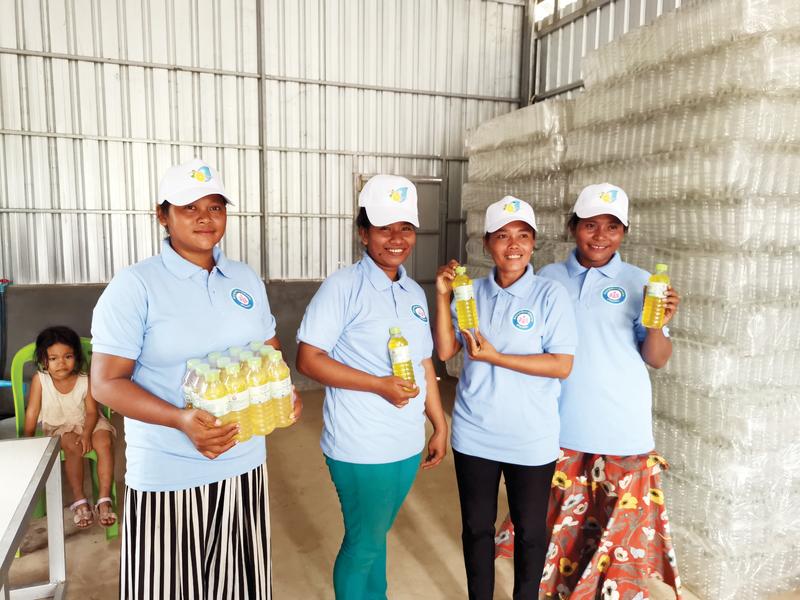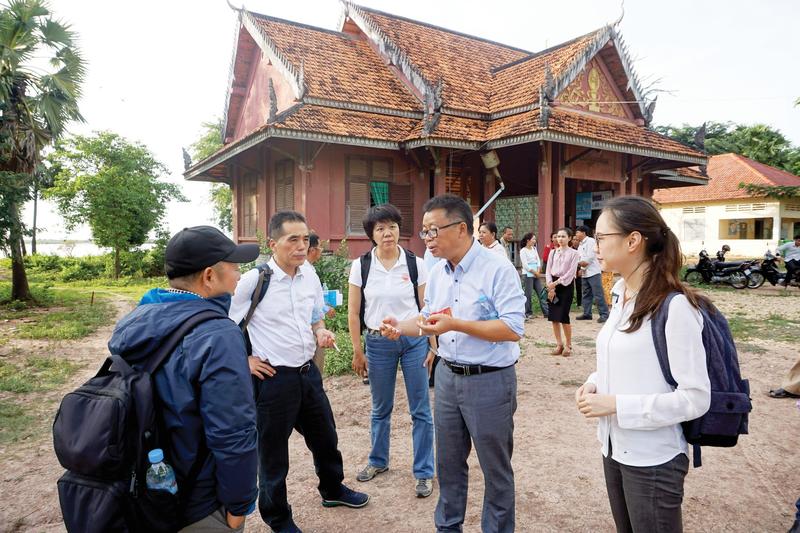 Workers display liquid detergent produced at a factory in the Cambodian village of Chheuteal Phlos. The factory is part of a Chinese pilot project aimed at alleviating poverty in the Southeast Asian nation. (ZHANG ZHAO / XINHUA)
Workers display liquid detergent produced at a factory in the Cambodian village of Chheuteal Phlos. The factory is part of a Chinese pilot project aimed at alleviating poverty in the Southeast Asian nation. (ZHANG ZHAO / XINHUA)
The rainy season in Southeast Asia used to be a miserable experience annually for Mao Tith and his family, as the hut they lived in, built from bamboo with a thatched roof of palm leaves, barely offered protection from torrential downpours.
However, the rain also provided an important source of water for the family, which lives in the small Cambodian village of Svay Ampear. During the dry season, they had to fetch water from a pond shared by the village.
A lack of secure housing and access to safe drinking water were not the only challenges faced by a team of Chinese experts that arrived in the village in 2017 to launch a pilot project aimed at alleviating poverty in Cambodia.
The project was part of a regional poverty reduction demonstration program announced by China during the 17th ASEAN-China, Japan and Republic of Korea leaders’ meeting in 2014.
China provided combined funding of 100 million yuan (US$15.4 million) to pilot poverty reduction in a total of six villages in Cambodia, Laos and Myanmar, which form part of the 10-member Association of Southeast Asian Nations.
Liu Xiaolin, an official from the bureau of rural vitalization in Sichuan province who took part in the project, said, “We took action based on the experience drawn from China’s poverty reduction campaign to try to identify the cause of poverty for each household before coming up with a targeted plan for each of them.”
With the joint efforts of Chinese experts and the Cambodian authorities, two villages in Cambodia — Svay Ampear and Chheuteal Phlos — were transformed by the end of last year. A community center was built to offer training sessions for villagers, and water supplies and electricity were connected to all households. A total of 71 homes were rebuilt and another 190 renovated.
Launched in tandem with methods tailored for the villagers to reduce their spending and earn more, the program introduced them to mushroom and vegetable cultivation and also to other professional skills.
The program in Cambodia typifies China’s broader steps to promote international development cooperation as the world’s largest developing nation.
With China achieving its goal of building a moderately prosperous society in all respects, officials and analysts said the nation would remain committed to furthering South-South Cooperation in its international development cooperation, with greater focus placed on improving livelihoods and building capacity for less-developed nations.
President Xi Jinping, who is also general secretary of the Communist Party of China Central Committee, has made renewed commitments to enhancing the well-being of humankind.
 Chinese experts conduct a field study during the regional poverty relief project in Cambodia. (PHOTO PROVIDED TO CHINA DAILY)
Chinese experts conduct a field study during the regional poverty relief project in Cambodia. (PHOTO PROVIDED TO CHINA DAILY)
In a keynote speech to the CPC and World Political Parties Summit in July, Xi said eradicating poverty has been a common aspiration for people from all countries and is an important objective for political parties. The CPC is willing to contribute more Chinese solutions and Chinese strength to reducing poverty worldwide, he said.
In a congratulatory message marking the fifth anniversary of the South-South Cooperation Assistance Fund and the Institute of South-South Cooperation and Development, Xi pledged to work with developing countries to further unleash the potential of South-South cooperation, share development opportunities with them and continue helping them achieve sustainable growth.
In a speech delivered at the APEC Informal Economic Leaders’ Retreat on July 16, the president unveiled a three-year US$3 billion aid package to support COVID-19 response and economic and social recovery in other developing countries.
According to the China International Development Cooperation Agency, or CIDCA, China has provided various types aid to more than 160 developing nations, carried out thousands of aid programs and offered over 400,000 training sessions to staff members.
Early in July, Luo Zhaohui, head of CIDCA, wrote in a signed article that China has always given priority in its international aid programs to improving people’s livelihoods — especially eliminating hunger and poverty.
“China’s foreign aid is conducted in ways that are similar to friends helping each other. It not only helps beneficiary countries improve people’s livelihoods and promote economic growth, but also creates a good external environment for China’s own development and the happiness of its people,” he wrote.
Lin, the project official, said the Chinese experts had to start from scratch when they arrived in Svay Ampear, which is about 50 kilometers from Phnom Penh, the Cambodian capital.
The fact that many villagers do not have their own farmland was the biggest obstacle to poverty alleviation, and the project officials had to match their expertise to meet local conditions.
The high cost of electricity, with private power companies charging as much as US$200 to connect each household, is another hurdle to improving livelihoods. According to the World Bank, 9.1 percent of the rural population in Cambodia did not have access to electricity in 2019.
Lin said: “There were no statistics for the number of people or households in the village. We planned to divert water from the Mekong River to supply tap water to the households, but there were no data or observation locations to provide any clues to the water quality.”
Impoverished farmers such as Mao Tith were the focus of attention for the project officials, who decided to help the 75-year-old and his family relocate to a new home.
Mao managed to raise US$350, while the project funded another US$830 to rebuild his home, a house made from a metal framework and which had a toilet made of concrete. The project officials helped him grow pepper on a patch of land he borrowed from a relative. The project also allowed him to raise a calf.
 A water tower built by China supplies safe drinking water to more than 800 households spanning two villages in Cambodia. (PHOTO PROVIDED TO CHINA DAILY)
A water tower built by China supplies safe drinking water to more than 800 households spanning two villages in Cambodia. (PHOTO PROVIDED TO CHINA DAILY)
Yuan Gang, a leading Chinese official for the project, said special attention was paid to letting poor households come up with their own initiatives to alleviate poverty.
For households without farmland, the experts helped them grow vegetables in pots, reducing their annual spending by US$180 to US$250. For those with farmland, a program was launched to help farmers grow mushrooms.
The project also provided 20 calves for the village and encouraged residents to share them as a source of income. A factory producing detergents was set up to offer job opportunities, with the farmers becoming shareholders.
Yuan said: “We paid special attention to getting poor farmers involved during implementation of the project. Their views were respected and their advice was adopted.”
K.Y. Sophal, director of the Cambodian Ministry of Rural Development’s Department of Rural Economy Development, who took part in the regional poverty reduction demonstration project, said the Chinese funds were directly channeled to the beneficiaries — the residents of the two villages.
“China’s expertise was instrumental in reducing poverty in both locations,” Sophal added.
“The Chinese experience proved more than useful to the villagers, the local government and especially my department. The project enabled us to learn a lot about the successful experience in China,” Sophal said in an online interview.
Although the project was only applied in two villages, the experience gained from it can be used to aid poverty reduction throughout Cambodia, he said.
With COVID-19 pushing more people below the poverty line in developing nations, including Cambodia, Sophal said China has a greater role to play in the global fight against extreme material deprivation.
According to official estimates in Cambodia, the poverty rate in 2014 was 13.5 percent compared with 47.8 percent in 2007, with more than 90 percent of the poor living in rural areas.
The pandemic, which has caused a sharp deceleration in most of Cambodia’s main growth engines, including tourism, exports and construction, has raised the rural poverty rate to 20 percent, Sophal said.
Xu Xiuli, dean of China Agricultural University’s College of International Development and Global Agriculture, said international development assistance from China could see greater focus on poverty reduction demonstration projects in Southeast Asia.
With the pandemic threatening to reverse the progress made toward achieving the United Nations 2030 Sustainable Development Goals, China has stepped up to contribute its strength and wisdom, she said.
The most recent example of this is Xi’s announcement of the US$3 billion aid package for developing countries, which Xu said would be “the helping hand such nations need the most”.
“China has given priority to contributing to the 2030 goals with its own development aid to promote the building of a community with a shared future for mankind,” she said.
“Poverty alleviation and reducing inequality will continue to be China’s strong focus.”


